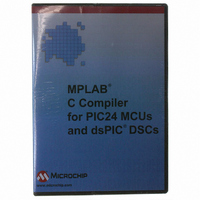SW006012 Microchip Technology, SW006012 Datasheet - Page 121

SW006012
Manufacturer Part Number
SW006012
Description
C COMPILER FOR DSPIC30F FAMILY
Manufacturer
Microchip Technology
Type
MPLAB® C30 Compilerr
Series
PIC24 & DsPICr
Specifications of SW006012
Supported Families
PIC24, DsPIC30F And DsPIC33F
Core Architecture
PIC, DsPIC
Kit Contents
Software And Docs
Mcu Supported Families
PIC24 MCUs And DsPIC DSCs
Tool Type
Compiler
Processor Series
PIC24, dsPIC
Lead Free Status / RoHS Status
Not applicable / Not applicable
For Use With/related Products
dsPIC30F
Lead Free Status / Rohs Status
Lead free / RoHS Compliant
- Current page: 121 of 248
- Download datasheet (3Mb)
© 2007 Microchip Technology Inc.
If there are no output operands but there are input operands, then there must be two
consecutive colons surrounding the place where the output operands would go. The
compiler requires that the output operand expressions must be L-values. The input
operands need not be L-values. The compiler cannot check whether the operands
have data types that are reasonable for the instruction being executed. It does not
parse the assembler instruction template and does not know what it means, or whether
it is valid assembler input. The extended asm feature is most often used for machine
instructions that the compiler itself does not know exist. If the output expression cannot
be directly addressed (for example, it is a bit field), the constraint must allow a register.
In that case, MPLAB C30 will use the register as the output of the asm, and then store
that register into the output. If output operands are write-only, MPLAB C30 will assume
that the values in these operands before the instruction are dead and need not be
generated.
EXAMPLE 8-4:
Some instructions clobber specific hard registers. To describe this, write a third colon
after the input operands, followed by the names of the clobbered hard registers (given
as strings separated by commas). Here is an example:
asm volatile ("mul.b %0"
: /* no outputs */
: "U" (nvar)
: "w2");
In this case, the operand nvar is a character variable declared in near data space, as
specified by the “U” constraint. If the assembler instruction can alter the flags (condition
code) register, add “cc” to the list of clobbered registers. If the assembler instruction
modifies memory in an unpredictable fashion, add “memory” to the list of clobbered
registers. This will cause MPLAB C30 to not keep memory values cached in registers
across the assembler instruction.
EXAMPLE 8-5:
You can put multiple assembler instructions together in a single asm template,
separated with newlines (written as \n). The input operands and the output operands’
addresses are ensured not to use any of the clobbered registers, so you can read and
write the clobbered registers as many times as you like. Here is an example of multiple
instructions in a template; it assumes that the subroutine _foo accepts arguments in
registers W0 and W1:
asm ("mov %0,w0\nmov %1,W1\ncall _foo"
: /* no outputs */
: "g" (a), "g" (b)
: "W0", "W1");
In this example, the constraint strings “g” indicate a general operand.
Mixing Assembly Language and C Modules
CLOBBERING REGISTERS
USING MULTIPLE ASSEMBLER INSTRUCTIONS
DS51284F-page 115
Related parts for SW006012
Image
Part Number
Description
Manufacturer
Datasheet
Request
R

Part Number:
Description:
Manufacturer:
Microchip Technology Inc.
Datasheet:

Part Number:
Description:
Manufacturer:
Microchip Technology Inc.
Datasheet:

Part Number:
Description:
Manufacturer:
Microchip Technology Inc.
Datasheet:

Part Number:
Description:
Manufacturer:
Microchip Technology Inc.
Datasheet:

Part Number:
Description:
Manufacturer:
Microchip Technology Inc.
Datasheet:

Part Number:
Description:
Manufacturer:
Microchip Technology Inc.
Datasheet:

Part Number:
Description:
Manufacturer:
Microchip Technology Inc.
Datasheet:

Part Number:
Description:
Manufacturer:
Microchip Technology Inc.
Datasheet:










